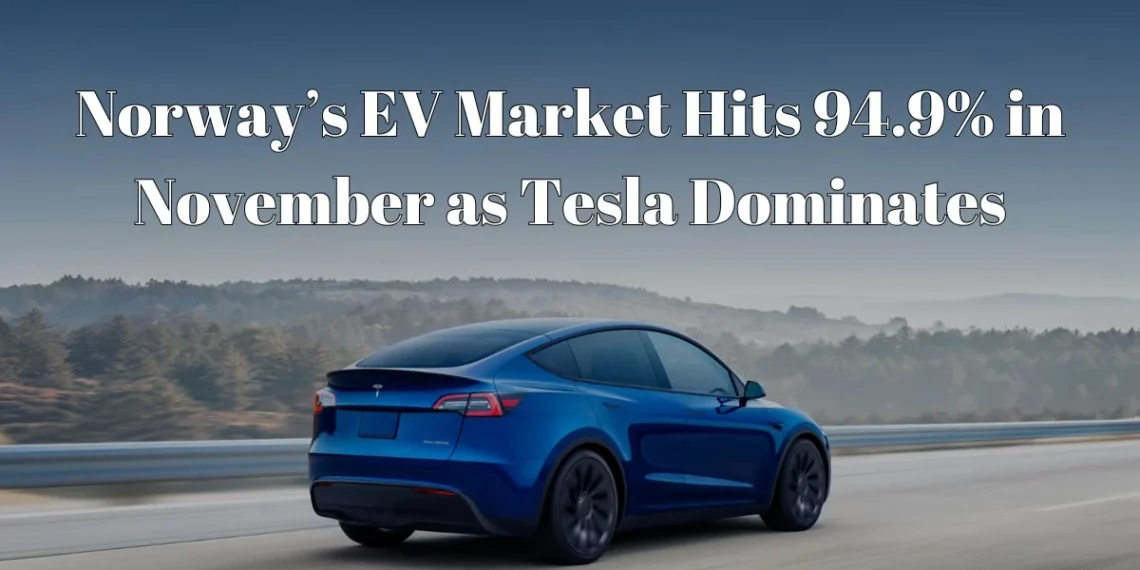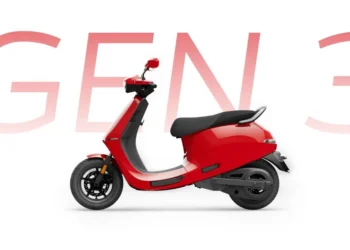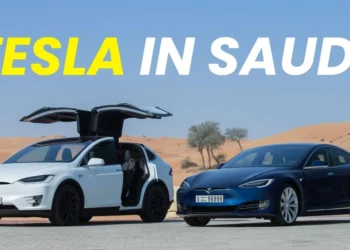Norway has once again set a new global benchmark for adopting electric vehicles (EVs). In November 2024, the Scandinavian country witnessed an astonishing 94.9% share of electric vehicles (EVs) in new car sales, marking a significant milestone in the global transition to zero-emission transportation. This exceptional feat has solidified Norway’s position as the world leader in EV adoption, pushing the boundaries of what’s possible in a market traditionally dominated by internal combustion engine (ICE) vehicles.
This blog explores how Norway achieved this record-breaking 94.9% share and what it means for the future of the automotive industry, both in Norway and globally.
Table of Contents
EVs Take Record Breaking 94.9% Share in Norway: What It Means
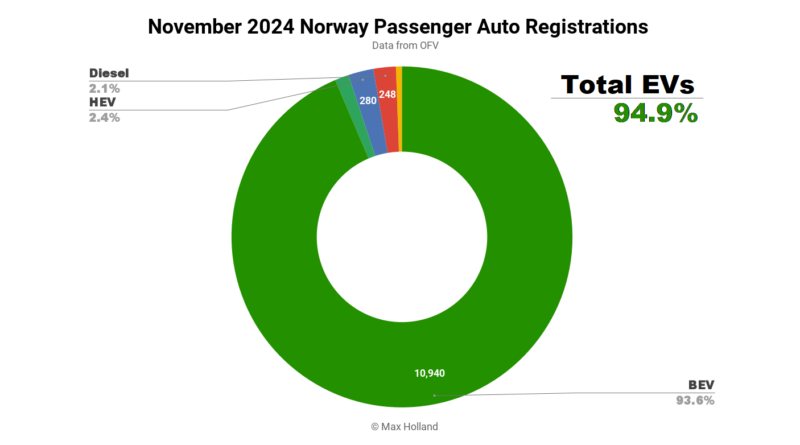
In November 2024, electric vehicles (EVs) accounted for 94.9% of all new car sales in Norway. This is a 4.3% increase from the same time last year, signaling not only a rapid shift in consumer preferences but also the success of Norway’s pro-EV policies. Out of these, 93.6% were Battery Electric Vehicles (BEVs), and only 1.3% were Plug-in Hybrid Electric Vehicles (PHEVs).
Key EV Sales Numbers:
- November 2024 EV Sales: 11,689 units
- BEV Share: 93.6%
- PHEV Share: 1.3%
- Top Selling EV Models: Tesla Model Y, Model 3, Volkswagen ID.4, BYD Sealion, Kia EV3
These numbers surpass the earlier records, including August 2024, when Norway recorded a 94.3% EV market share. The increasing dominance of Tesla, with its Model Y leading the charge, along with the rise of newer entrants like BYD and Kia, reflects a growing diversity of affordable and high-performance electric cars in the Norwegian market.
The Driving Forces Behind Norway’s EV Success
1. Generous Government Incentives
Norway’s government offers a range of incentives that have made EVs more affordable. These include:
- Exemption from Value-Added Tax (VAT)
- Exemption from tolls and ferry charges
- Free access to bus lanes
- Reduced registration fees
These policies have made EVs more financially attractive, encouraging consumers to make the switch from fossil-fuel-powered vehicles.
2. Infrastructure Expansion
The country’s robust charging network, with over 20,000 charging points, has made owning an EV highly convenient. As more people embrace EVs, the infrastructure continues to expand, ensuring that drivers have easy access to charging stations across the country.
3. Growing Consumer Awareness
Norwegian consumers are increasingly prioritizing sustainability. With growing environmental concerns, more individuals and families are making the switch to EVs, not just for their lower running costs but also for their smaller carbon footprints.
Key EV Models Driving Norway’s Success
Tesla has continued to dominate Norway’s EV market, with its Model Y and Model 3 taking the top two spots for the month. But other notable models are also catching the attention of Norwegian drivers:
Top 5 Best-Selling EVs in November 2024:
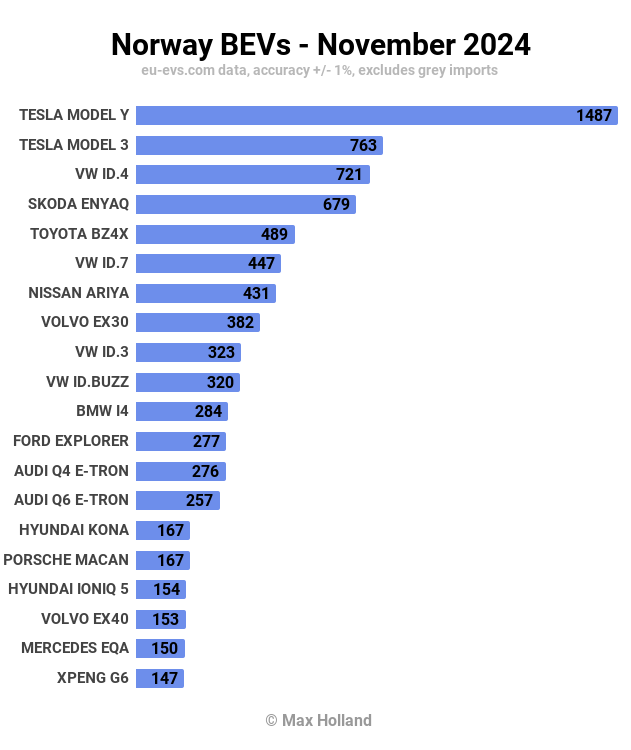
| Model | Units Sold |
|---|---|
| Tesla Model Y | 1,487 |
| Tesla Model 3 | 763 |
| Volkswagen ID.4 | 721 |
| Skoda Enyaq | 545 |
| Toyota bZ4X | 487 |
This mix of affordable mass-market models like the Volkswagen ID.4 and premium EVs such as the Tesla Model Y indicates the diversity in consumer preferences, catering to various budgets and needs.
Challenges and Opportunities for the EV Industry
Despite the impressive adoption rates, there are still a few challenges that need to be addressed:
- Winter and Remote Areas: Norway’s harsh winters and challenging geographical conditions present unique challenges for EVs. While battery technology is improving, there are still concerns about range, charging infrastructure, and towing capacity in remote northern regions.
- Electric Vans and Trucks: While passenger vehicles have dominated the EV market, electric vans and trucks still lag. Currently, diesel vans account for about 70% of new van registrations, with electric vans making up only 30% of the market.
However, there are opportunities as well:
- Increased Availability of Affordable EVs: Models like the Dongfeng Nammi Box, a compact and affordable EV, are proving to be strong contenders in the lower price range.
- Improvements in Charging Infrastructure: The expansion of the fast-charging network will make it easier for consumers to transition to EVs, particularly in rural and northern areas.
- Electric Heavy Trucks: With trucks slowly transitioning to electric, Norway could see significant growth in this segment by 2025, further solidifying its leadership in the zero-emission market.
Øyvind Solberg Thorsen, Director of the Norwegian Road Federation (OFV) said that
“No other country in the world is experiencing the EV surge that we are currently seeing in Norway. If this trend continues, we will soon be on track to meet our goal of 100% zero-emission vehicles by 2025.”
Impact of Norway’s EV Milestone on Global Trends
Norway’s success is increasingly being viewed as a model for the rest of the world. While EV adoption in Europe lags behind Norway’s record-breaking pace, the country’s efforts are influencing global policies and market trends. With countries like the UK and Germany setting their own ambitious EV goals, Norway’s experience offers valuable insights into the importance of policy incentives and infrastructure investment.
As Solberg Thorsen observes:
“If the trend continues, we will soon be on our way to achieving our goal of 100% zero-emission cars by 2025.”
This ambition is setting the stage for other nations to follow suit, potentially leading to a broader global transition to clean, electric transportation.
Conclusion
Norway’s achievement of 94.9% EV market share in November 2024 is more than just a statistic; it marks a turning point in the global shift toward electric vehicles. As the country leads the way, other nations are taking note and implementing similar policies to encourage EV adoption. With Tesla, BYD, and others gaining ground, the future of Norway’s EV market looks incredibly promising.
As the world watches, Norway’s success serves as both a blueprint and a challenge for the rest of the world. Will other countries follow suit? Only time will tell, but one thing is clear—Norway is not just on track to meet its 2025 zero-emission goal; it is setting the stage for a future where electric vehicles dominate the roads globally.
FAQS:
What is the significance of Norway’s 94.9% EV market share?
It is a global record, marking Norway as the leader in EV adoption. This milestone highlights the country’s successful policies, infrastructure, and consumer shift toward electric cars.
Which EV model is leading in Norway?
The Tesla Model Y is the best-selling EV, followed closely by the Tesla Model 3.
What role do government policies play in Norway’s EV success?
Policies such as tax exemptions, free tolls, and subsidies for EVs have been crucial in making electric vehicles more affordable and appealing to Norwegian consumers.
How is Norway’s EV success influencing other countries?
Norway’s success is a model for other nations, showcasing the potential benefits of strong governmental incentives and investment in charging infrastructure.
What challenges remain in Norway’s EV transition?
Remote areas with extreme weather conditions and demanding vehicle requirements still face challenges in adopting fully electric solutions. However, models like the Maxus eTerron 9 aim to address these needs.
What is the expected future of EVs in Norway?
Norway aims for 100% zero-emission vehicles by 2025, with continued growth in EV adoption expected, especially as more affordable models become available.


